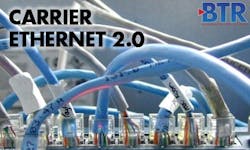Carrier Ethernet 2.0 Plays to Cable's Strengths
There are two main drivers for MSOs' initiatives in the commercial services sector: Companies want to more fully market to larger enterprises and to get their share of the cellular backhaul business, which is growing as LTE networks roll out.The industry's main platform for succeeding in these market segments - both of which require extraordinarily robust and reliable networks - is Carrier Ethernet. On Feb. 20, the Metro Ethernet Forum announced that Comcast (NASDAQ:CMCSA) was the first carrier to earn Carrier Ethernet 2.0 (CE 2.0) certification.Though it is the biggest cable operator, Comcast is a relative newcomer to commercial services and is not leading the pack. In a ranking of cable operators by billable port share that was released last week, Vertical Systems Group ranked Comcast fifth after, in descending order, Cox, Time Warner Cable (NYSE:TWC), Charter (NASDAQ:CHRT) and Lightpath (NYSE:CVC),.Thus, it is interesting that the company won the race to certification. Comcast, of course, is the most influential operator, and what it does says something about the industry’s priorities. In any case, Comcast isn't accustomed to being fifth biggest in anything. "I think that we were first because we wanted to be first," said Karen Schmidt, the executive director of product marketing for Comcast Business. "We are still new to the market and have a great network. We wanted to prove that and tell our story."The cable industry, of course, is very familiar with Ethernet, and CE 2.0 dovetails nicely with its skillset. There are four pieces to CE 2.0, according to Daniel Bar-Lev, the director of certification programs for the Metro Ethernet Forum. The first three focus on fiber topographies within a network: E-line (point-to-point), E-Lan (multipoint-to-multipoint) and E-Tree (tree and branch). The fourth element is E-Access, which is a point-to-point process for passing traffic to a partnering network. CE 2.0 has three pillars, Bar-Lev said:
- CE 2.0 allows carriers to distinguish class of service (CoS). For instance, carriers now will have an industry-recognized way to distinguish between a guaranteed and best-effort level of service for a customer.
- CE 2.0 creates an industry-recognized means of exchanging traffic between carriers or other large entities. Thus, if a company has facilities served by two service providers - or if a service provider is exchanging traffic with a big private network - CE 2.0 provides a way to offer services that have end-to-end service level agreements (SLAs) and management control.
- CE 2.0 enhances manageability with fault tolerance and other tools.
